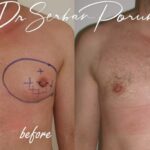Ginecomasty
DEFINITION
Gynecomastia is an excessive development of the male breast, on one or both sides, in a symmetrical or asymmetrical manner.
It is generally painless or painless, but can sometimes be accompanied by increased sensitivity of the chest.
Theoretically, true gynecomastia is related only to the mammary gland, and false gynecomastia contains only adipose tissue. In practice, both components, glandular and fatty, are frequently associated.
Gynecomastia is very common, particularly in certain periods of life: in the newborn (60% of cases), at the time of puberty (60% of cases) when it generally disappears in less than two years. In adult men, gynecomastia occurs in approximately 30% of cases up to 60% of cases after 70 years.
In the vast majority of cases, gynecomastia is normal, or physiological, or "idiopathic", meaning no cause can be found. However, before this can be stated, a complete assessment must be performed, looking for a possible pathological or medicinal cause.
An ultrasound and/or a mammogram are often useful to specify the glandular component and eliminate a possible tumor.
PATHOLOGICAL AND MEDICINAL CAUSES
Among the diseases that can cause gynecomastia, we can cite:
- tumors of the testicle, adrenal gland, pituitary gland, lung
- Klinefelter syndrome, characterized by the existence in a man of one, two or three supernumerary X chromosomes
- kidney, thyroid diseases, liver cirrhosis
- testicular failure (hypogonadism)
Among the medicinal causes, we can cite the following drugs that can cause gynecomastia: estrogens, cimetidine, spironolactone
PRINCIPLES
If a cause has been found, of course it must be treated as a priority.
Surgical treatment of gynecomastia is particularly aimed at embarrassing forms due to their volume or sensitivity, as well as in the case of gynecomastia that is difficult to tolerate psychologically. In the case of adolescents, approximately 2 years of evolution must be waited before recommending the intervention.
Liposuction is a method that cannot be recommended alone unless the breast content is represented only by fat (false gynecomastia).
In the case of true gynecomastia, the mammary gland, of firm consistency, cannot be aspirated, and can only be removed surgically. Everything therefore depends on the size of the breast and the elasticity of the skin.
- if the skin is elastic and the breast is not very large, which happens in the vast majority of cases, the entire intervention can be performed through a short, discreet incision located on the periphery of the areola.
- if there is a significant skin surplus and the skin is not elastic, the incisions are horizontal, more or less long, located at the level of the areola
- if the breast volume is very important, the horizontal incisions are located lower, and can be completed by a vertical and periareolar incision, or even the areolas can be amputated and grafted in their natural position.
THE RESULT
It can be fully appreciated from 6 months to a year post-operatively. In addition to local improvement, it generally has an important benefit for weight balance, sports practice, clothing possibilities and psychological state.
It is only necessary to understand the time required for the scars to fade,
and to have good supervision during this period, once every 3 months in consultation.
POSSIBLE COMPLICATIONS
Fortunately, serious complications are rare as a result of a gynecomastia cure, carried out according to the rules. In practice, the vast majority of interventions are carried out without any problems and patients are fully satisfied with the result.
However, despite the low frequency, you should be aware of the possible complications:
– accidentele trombo-embolice thromboembolic accidents (phlebitis, pulmonary embolism), are among the most dangerous. The risks of their occurrence are increased if such an accident is in the patient's history. Rigorous preventive measures should minimize their incidence: wearing antithrombotic stockings, early mobilization and possible anticoagulant treatment.
the appearance of an infection requires antibiotic treatment and sometimes surgical drainage
- a hematoma may require evacuation
- a necrosis of the skin or areola, a fact very rarely observed with modern techniques, may be responsible for a delay in healing
- alterations in sensitivity, especially at the nipple level, may be observed, but normal sensitivity most often reappears after a period of 6-18 months.
- the evolution of scars, in particular, may be unfavorable with the appearance of hypertrophic scars or even keloid scars, with an unpredictable appearance and evolution and which may compromise the aesthetic aspect of the result, requiring specific local treatments that are often long-lasting.
as imperfections of the result can be cited: insufficient correction (with residual excess of subcutaneous fat and/or skin), concave appearance of the chest, related to the thickness of the residual fat layer around the breast that was removed (a complementary liposuction can be proposed to mitigate), more or less undulating appearance of the chest, if the skin has not retracted sufficiently or correctly. This aspect can be mitigated at the cost of a horizontal scar on the breast, since it is necessary to remove excess skin.
Overall, the risks should not be overestimated, but simply taking note that a surgical intervention, even if seemingly simple, always involves a small part of randomness.
By resorting to a qualified Plastic Surgeon, you will ensure that he has the competence and training necessary to know how to avoid these complications, or to treat them effectively in the event of their occurrence.
Dr. Serban Porumb has a complete experience with this type of intervention, having over 25 years of experience in plastic surgery, of which 6 years of specialization performed with the most renowned doctors and in the most renowned hospitals and clinics in Portugal, in USA and in Paris, France, as well as over 12,000 surgical procedures performed.






